
Water Skiing
Water Skiing 101
Ride the Wake!
There is nothing like spending a warm summer day by the water. But water-skiers will tell you that even better is a day spent water skiing along on the surface of the water with the wind in their hair. Don’t think because you have a disability that you can’t join the fun. The sport is easily adaptable and after a lesson or two, you’ll wonder why it took you so long to try it!
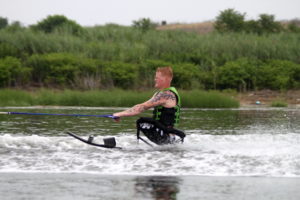 People of all ages and abilities can enjoy the fun and excitement of water skiing. All that’s needed is a desire to learn and a body of water that can accommodate a high-speed boat.
People of all ages and abilities can enjoy the fun and excitement of water skiing. All that’s needed is a desire to learn and a body of water that can accommodate a high-speed boat.
Adaptive equipment allows a skier to participate in a range of water sports from skimming the surface in an inner tube, to competitive skiing including slalom, tricks, and jumping. Many leg and arm amputees use the same equipment as able-bodied athletes, but adaptive devices such as sit-skis, outriggers, and shoulder slings, accommodate various levels of ability.
“The availability of water skiing to a wide segment of the disabled population is part of its attraction,” said Bill Bowness, Technical Director at Achieve Tahoe, a chapter of Disabled Sports USA. Bowness is also the first adaptive water- skier to be inducted into the USA Water Ski Hall of Fame and the International Waterski and Wakeboard Federation.
Getting on the Water
When a student learns to water ski, they are first assessed to determine which equipment will best suit their individual needs. Trained volunteers check strength, mobility, and balance, talk with the student about his or her goals, and discuss any red flags that might be indicated on the participant information sheet (i.e. medications, surgeries, allergies, etc.).
While Bowness recommends attending a certified program to first learn to ski, he believes that another appeal of the sport is that it is completely integrated and adaptive athletes can participate along with their family and friends once they’ve learned the appropriate skills from their instructor.
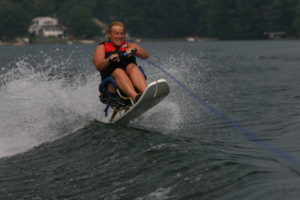 “An athletic paraplegic is going to be completely independent and self- sufficient after two times on the water,” he said. “They would be able to go out, grab a ski and never come back to a program. They would be able to ski with their friends from now on.”
“An athletic paraplegic is going to be completely independent and self- sufficient after two times on the water,” he said. “They would be able to go out, grab a ski and never come back to a program. They would be able to ski with their friends from now on.”
While the high-speed sport might seem intimidating for those who don’t consider themselves athletic, Bowness encourages anyone to try it. At the first lesson, participants should expect to be out in the water within the first ten to fifteen minutes after meeting with their instructor and discussing their previous experience, goals, and any potential concerns.
“Safety is the only restriction,” Bowness said. “The person needs to be able to turn over from face down to face up.”
This means that when wearing a Personal Flotation Device (Pfd), also called a life jacket, the skier should be able to independently turn over in the water and keep their head above water. In addition to the Pfd, the water-skier should plan to wear the appropriate clothing for their area. Skiers in areas with warmer weather can wear a standard bathing suit or water-appropriate clothing and sunscreen, while those in areas with cooler water may consider a wet suit to help with the cold.
Find a Program Near You
Ready to try it? Check out one of the many Move United Chapters that offer water skiing!
Also, several other companies throughout the country offer adaptive water skiing.
Equipment and Adaptations
Making the Ski Work for You
There is a variety of adaptive ski equipment available that allows individuals with physical disabilities to enjoy the sport of water skiing.
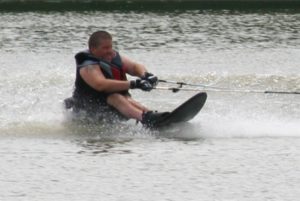 Sit Ski – Sit skis allow those with spinal cord injuries, or those with balance issues that might prevent them from standing up and being pulled behind the boat, to experience the excitement of water skiing. A sit ski is designed to have a seat or cage fastened to the top so that the skier can remain in the seated position. Some sit skis include a starting block, which is a cleat that holds the rope for those with grip issues. Sit skis come in three levels: beginner, intermediate, and advanced. Width is the biggest difference in these designs. Beginner sit skis are as wide as 18 inches to allow easier balance for the skier, whereas a tournament ski is in the 11- or 12-inch range. From there the material, amount of concave, type of edges, and other factors will provide significant performance differences for the skier.
Sit Ski – Sit skis allow those with spinal cord injuries, or those with balance issues that might prevent them from standing up and being pulled behind the boat, to experience the excitement of water skiing. A sit ski is designed to have a seat or cage fastened to the top so that the skier can remain in the seated position. Some sit skis include a starting block, which is a cleat that holds the rope for those with grip issues. Sit skis come in three levels: beginner, intermediate, and advanced. Width is the biggest difference in these designs. Beginner sit skis are as wide as 18 inches to allow easier balance for the skier, whereas a tournament ski is in the 11- or 12-inch range. From there the material, amount of concave, type of edges, and other factors will provide significant performance differences for the skier.
“Probably 80 percent of our students use a sit-down water ski that was designed by Royce Andes, one of our instructors,” says Haakon Lang-Ree, Executive Director of Disabled Sports USA Far West. Andes, a quadriplegic after a water skiing accident, designed the Kan Ski Freedom, a sit ski for people who are unable to ski standing up.
Outriggers – Outriggers are short ski tips attached to the edge of the sit ski. The outriggers function the same as those of an outrigger canoe, providing balance to the ski and making it more stable.
“They almost double the amount of stability,” says Bowness. “With any amount of forward movement the ski will stay upright so individuals with severe balance or coordination issues are able to get out and enjoy the water-ski experience.”
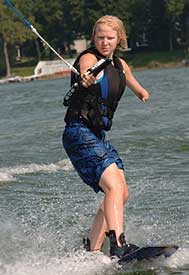 Stand-Up Ski – Individuals who are able to stand while being pulled behind the boat will use a traditional stand-up ski. Those who need a bit more balance assistance might use a jump ski, the ski designed for competitive jumpers because it has a flat bottom and 90-degree edges, which makes it more stable than the common stand- up ski. Another adaptation might be to adjust the binding location; for example, moving the binding for a single leg amputee to the center of the ski to adjust for their weight displacement.
Stand-Up Ski – Individuals who are able to stand while being pulled behind the boat will use a traditional stand-up ski. Those who need a bit more balance assistance might use a jump ski, the ski designed for competitive jumpers because it has a flat bottom and 90-degree edges, which makes it more stable than the common stand- up ski. Another adaptation might be to adjust the binding location; for example, moving the binding for a single leg amputee to the center of the ski to adjust for their weight displacement.
Boom – The boom is a long metal arm, approximately 20 feet long, which attaches to the side of the boat and runs perpendicular to the wake. Skiers hold onto the boom instead of being towed behind the boat by a rope. This allows skiers to get a feel for the water while providing balance assistance and keeping them close to the boat for more instruction as needed. The boom is an effective tool that is often used for new skiers (before starting them on a long tow rope), amputees, people with visual impairments, and those with balance issues.
Triple Bar – Another option to the boom is the triple bar, which is a modified handle that is six feet long and made of three separate handles attached to three separate tow ropes. This allows an instructor on either side of the student to help physically assist a beginner skier and then separate when the skier becomes confident enough to ski alone.
Arm Sling – For those who have trouble gripping the tow rope with one arm, an arm sling offers one solution. The sling is a modified handle that fits into a harness worn much like a Pfd around the skier’s shoulders. The sling takes up the forces that the missing or impaired arm would have been taking up otherwise. In the event of a fall, the skier would release the handle with their good arm, automatically unclipping it from the harness, so the athlete doesn’t have to worry about any drag.
Guide and Whistle – Individuals with visual impairments can ski without any adaptive equipment, but Bowness recommends that for safety purposes they try the triple bar with an instructor for their first time out to get a feel for the water. Once they feel confident to go it alone, a guide in the boat can provide whistle commands to provide information about turns, speed, and upcoming obstacles.
As with beginner able-bodied stand-up skiers, ski tip connectors can also be used to minimize side-to-side movements.
Adaptive Water Skiing Equipment Suppliers
Body Positioning
All skiers, stand-up and sit-down alike, rely on straight arms while skiing to reduce fatigue. However, stand-up skiers lean back on the rope handle to maintain balance. Sit-down skiers, conversely, “break” at the waist and lean as far forward as possible. The sit ski and cage are designed to maximize this position because many skiers who use this type of equipment do not have the torso musculature to lean back against the pull of the boat.
Competing
Mastered the Basics? Try Competing
If you’ve been water skiing for a couple of summers, or just quickly progressed to master status, consider training for a competition and
testing your skills against other high-level athletes. USA Water Ski, the national governing body for water skiing and the American arm of the International Waterski and Wakeboard Federation (Iwwf) hosts the U.S. Disabled Nationals and several regional tournaments on both coasts with categories for a number of different disability classifications. The regional tournaments are introductory-level competitions and typically last for two days, with the first day being a clinic that teaches new competitive athletes the basics of competition, and the second day being the actual competition.
Don’t have an adaptive tournament near you? All USA Water Ski competitions are integrated, meaning an adaptive athlete can enter any local tournament and compete.Competition categories include:
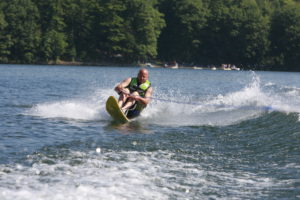 Slalom – A course that is 800 feet long, in which the skier goes around six offset buoys while being towed by the boat. Each time the skier successfully completes the course, the boat speed is increased by two miles per hour, until the maximum speed is reached, at which point the skier’s rope length is shortened by predetermined increments. Skiers continue until they fall or do not go around a buoy.
Slalom – A course that is 800 feet long, in which the skier goes around six offset buoys while being towed by the boat. Each time the skier successfully completes the course, the boat speed is increased by two miles per hour, until the maximum speed is reached, at which point the skier’s rope length is shortened by predetermined increments. Skiers continue until they fall or do not go around a buoy.
Trick – The athlete completes two, 20-second passes, in which they attempt to do as many tricks (jumps, grabs and surface tricks) as possible without duplicating a trick. Wakeboards are allowed as trick skies, but in order for the skier to get full credit, the ski cannot be any wider than 30 percent of its length. Each trick has a point designation based on its difficulty level.
Jump – The athlete skis over a ramp that is 14 feet wide and 22 feet long. Skiers select the ramp height they want from one meter, 1.25 meters, and 1.5 meters, and try to go the farthest distance possible in the air and ski away.
Wakeboard – Similar to trick, the athlete completes two, 20-second passes, but they use a wakeboard and the focus is more on air tricks ( jumps and grabs). Points are awarded for difficulty.
One Athlete’s Story
When it comes to water skiing, Wyatt Hogue of Chattanooga admittedly has some advantages. He lives in a climate that provides a long, warm-weather season, he owns his own boat, and he learned the sport when he was 15 – and had the use of both of his biological arms. When a car accident at age 22 resulted in an above-the-elbow amputation, he had the same questions as almost every amputee – ‘will I be able to do what I did before?’
For Wyatt the answer was yes. Now 34, he is frequently seen slalom skiing, wakeboarding, or hydrofoiling behind his Supra Launch on the Chickamauga Reservoir. “I would tell anyone ‘you can do it. It just takes a little more patience,’” he said. “The key is you have to want it.”
Post-amputation, Wyatt amazed his friends when he began skiing again, including deepwater starts, instead of dock starts. “Even though my friends told me I wouldn’t be able to do it, I did,” he said. However, having only one biological arm presented some challenges when trying to maintain grip at the start of a run. “There’s a tremendous amount of force at a deepwater start,” Wyatt said. “Because of the force of the boat pulling me out of the water, by the time I got up on the ski, I was worn out.”
Wyatt figured there had to be another method that would provide him the power to get waterborne without as much stress on his arm, so he searched the Internet and read about Tammy Allard, a right below-elbow amputee, and a champion skier. Her record includes winning two gold medals at the 2000 Nationals Disabled Water Ski Championships, two gold medals at the 2001 Nationals, and 2003 National Slalom Champion.
Wyatt contacted Tammy for advice, and she told him about the Delgar Sling. The Delgar Sling is a harness device with a strap that connects from the shoulder and hooks to the ski rope handle. It compensates for the uneven pull of the rope otherwise experienced by someone using only one arm.
To Learn More
National Governing Body- USA Water Ski
International Governing Body- International Waterski and Wakeboard Federation


